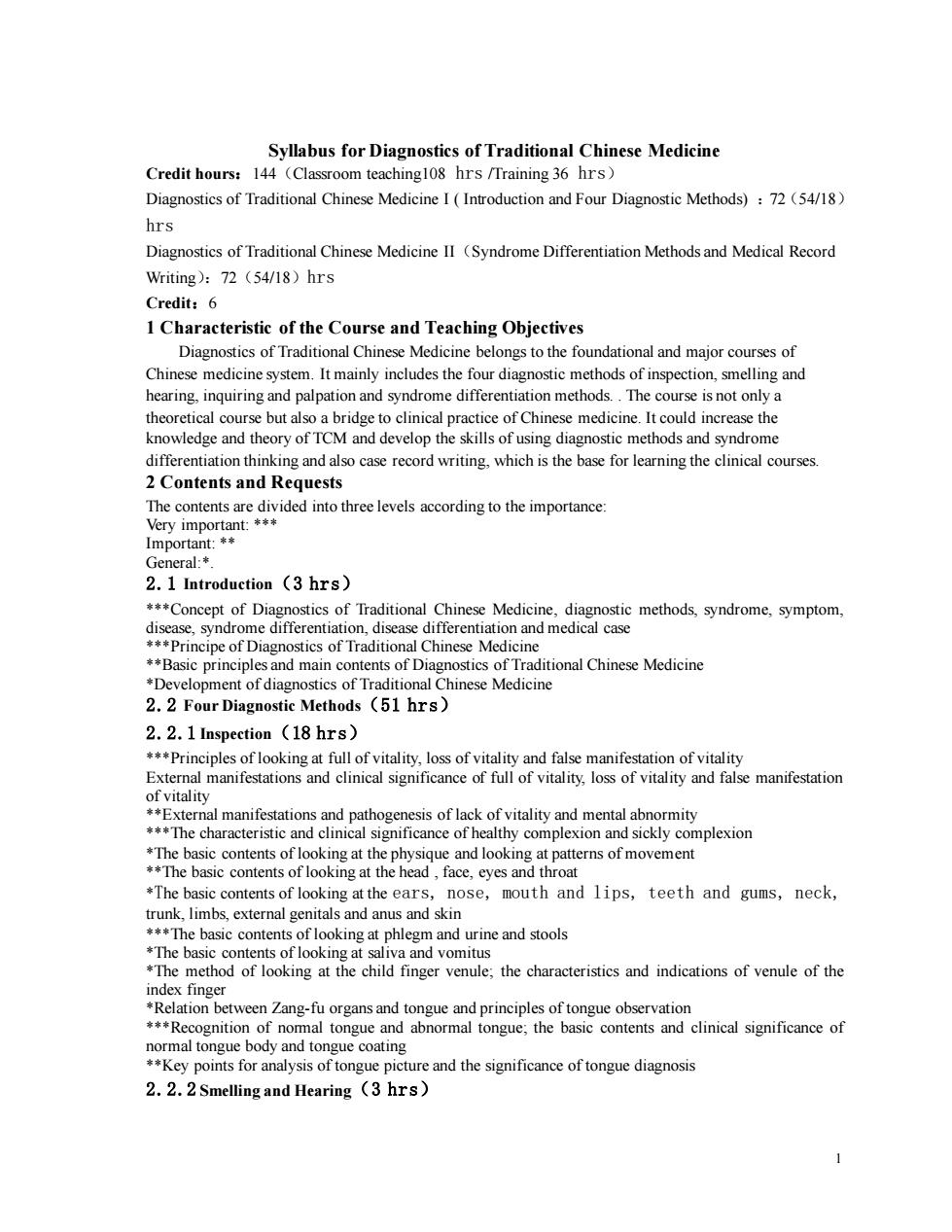正在加载图片...

Syllabus for Diagnostics of Traditional Chinese Medicine Credit hours:144 (Classroom teaching108 hrs /Training 36 hrs) Diagnostics of Traditional Chinese Medicine I Introduction and Four Diagnostic Methods):72 (54/18) hrs Diagnostics of Traditional Chinese Medicine II (Syndrome Differentiation Methods and Medical Record Writing):72 (54/18)hrs Credit:6 1 Characteristic of the Course and Teaching Objectives Diagnostics of Traditional Chinese Medicine belongs to the foundational and major courses of Chinese medicine system.It mainly includes the four diagnostic methods of inspection,smelling and hearing,inquiring and palpation and syndrome differentiation methods..The course is not only a theoretical course but also a bridge to clinical practice of Chinese medicine.It could increase the knowledge and theory of TCM and develop the skills of using diagnostic methods and syndrome differentiation thinking and also case record writing,which is the base for learning the clinical courses. 2 Contents and Requests The contents are divided into three levels according to the importance: Very important:** Important:* General: 2.1 Introduction (3 hrs) ***Concept of Diagnostics of Traditional Chinese Medicine,diagnostic methods,syndrome,symptom, disease,syndrome differentiation,disease differentiation and medical case ***Principe of Diagnostics of Traditional Chinese Medicine **Basic principles and main contents of Diagnostics of Traditional Chinese Medicine *Development of diagnostics of Traditional Chinese Medicine 2.2 Four Diagnostic Methods (51 hrs) 2.2.1 Inspection (18 hrs) ***Principles of looking at full of vitality,loss of vitality and false manifestation of vitality External manifestations and clinical significance of full of vitality,loss of vitality and false manifestation of vitality **External manifestations and pathogenesis of lack of vitality and mental abnormity ***The characteristic and clinical significance of healthy complexion and sickly complexion *The basic contents of looking at the physique and looking at patterns of movement **The basic contents of looking at the head,face,eyes and throat *The basic contents of looking at the ears,nose,mouth and lips,teeth and gums,neck, trunk,limbs,external genitals and anus and skin ***The basic contents of looking at phlegm and urine and stools *The basic contents of looking at saliva and vomitus *The method of looking at the child finger venule;the characteristics and indications of venule of the index finger *Relation between Zang-fu organs and tongue and principles of tongue observation ***Recognition of nommal tongue and abnormal tongue;the basic contents and clinical significance of normal tongue body and tongue coating **Key points for analysis of tongue picture and the significance of tongue diagnosis 2.2.2 Smelling and Hearing (3 hrs) 11 Syllabus for Diagnostics of Traditional Chinese Medicine Credit hours:144(Classroom teaching108 hrs /Training 36 hrs) Diagnostics of Traditional Chinese Medicine I ( Introduction and Four Diagnostic Methods) :72(54/18) hrs Diagnostics of Traditional Chinese Medicine II(Syndrome Differentiation Methods and Medical Record Writing):72(54/18)hrs Credit:6 1 Characteristic of the Course and Teaching Objectives Diagnostics of Traditional Chinese Medicine belongs to the foundational and major courses of Chinese medicine system. It mainly includes the four diagnostic methods of inspection, smelling and hearing, inquiring and palpation and syndrome differentiation methods. . The course is not only a theoretical course but also a bridge to clinical practice of Chinese medicine. It could increase the knowledge and theory of TCM and develop the skills of using diagnostic methods and syndrome differentiation thinking and also case record writing, which is the base for learning the clinical courses. 2 Contents and Requests The contents are divided into three levels according to the importance: Very important: *** Important: ** General:*. 2.1 Introduction(3 hrs) ***Concept of Diagnostics of Traditional Chinese Medicine, diagnostic methods, syndrome, symptom, disease, syndrome differentiation, disease differentiation and medical case ***Principe of Diagnostics of Traditional Chinese Medicine **Basic principles and main contents of Diagnostics of Traditional Chinese Medicine *Development of diagnostics of Traditional Chinese Medicine 2.2 Four Diagnostic Methods(51 hrs) 2.2.1 Inspection(18 hrs) ***Principles of looking at full of vitality, loss of vitality and false manifestation of vitality External manifestations and clinical significance of full of vitality, loss of vitality and false manifestation of vitality **External manifestations and pathogenesis of lack of vitality and mental abnormity ***The characteristic and clinical significance of healthy complexion and sickly complexion *The basic contents of looking at the physique and looking at patterns of movement **The basic contents of looking at the head , face, eyes and throat *The basic contents of looking at the ears, nose, mouth and lips, teeth and gums, neck, trunk, limbs, external genitals and anus and skin ***The basic contents of looking at phlegm and urine and stools *The basic contents of looking at saliva and vomitus *The method of looking at the child finger venule; the characteristics and indications of venule of the index finger *Relation between Zang-fu organs and tongue and principles of tongue observation ***Recognition of normal tongue and abnormal tongue; the basic contents and clinical significance of normal tongue body and tongue coating **Key points for analysis of tongue picture and the significance of tongue diagnosis 2.2.2 Smelling and Hearing(3 hrs)